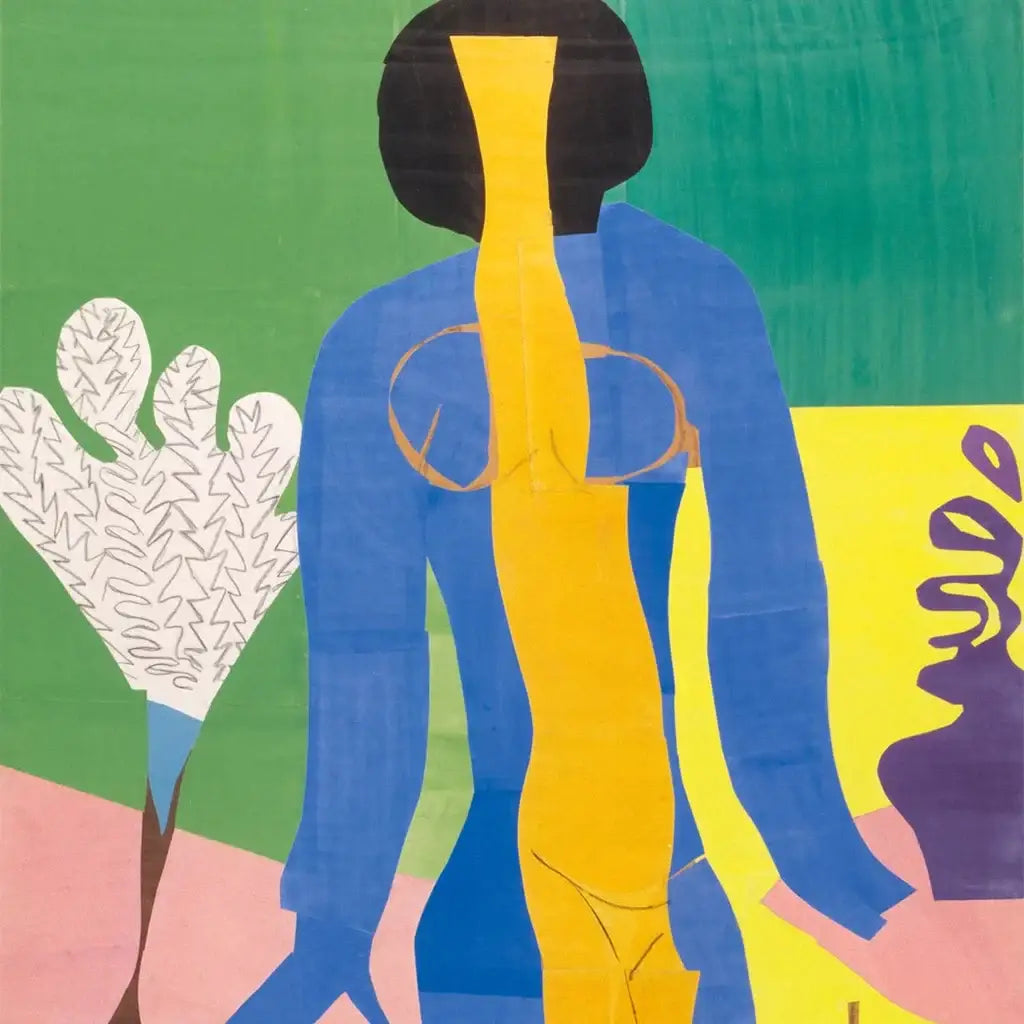From Dada to Feminism: Exploring the Impact of Famous Collage Artists
Collage art is a unique form of artistic expression that involves combining different elements and materials to create a cohesive and visually stunning image.
Collage art has a rich history dating back to 12th century Japan — a loooong time before Pablo Picasso and Georges Braque reimagined the form as the technique of papier collé (pasted paper) back in the 1910s. Over the years, there have been numerous collage artists who have made a significant impact on the art world with their innovative styles and techniques.
In this article, we'll meet 11 famous collage artists who have made an indelible mark on the art world. Being a collage artist myself, I was surprised how few of these particular artists I knew.
How about you?
11 Famous Collage Artists Who Defined the Artform
1
Hannah Höch
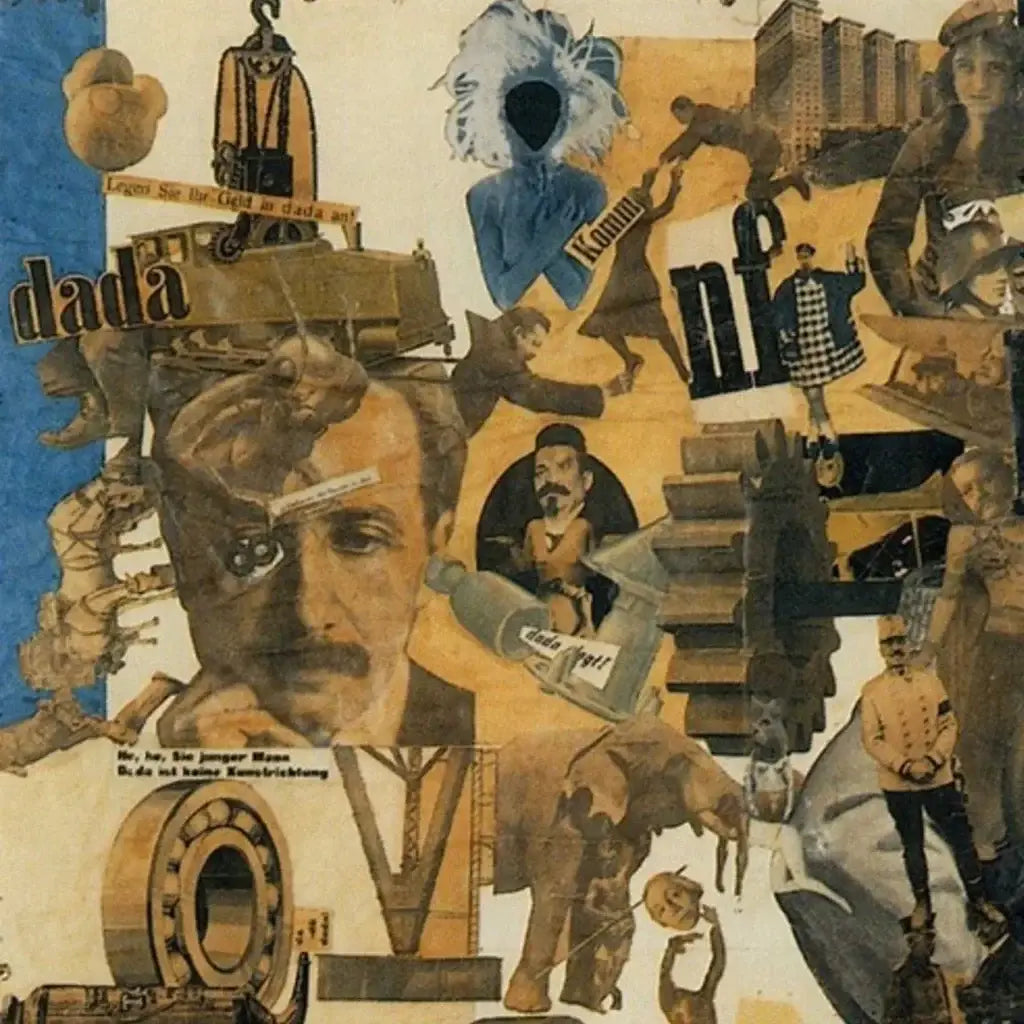
Hannah Höch, Cut with the Dada Kitchen Knife through the Last Weimar Beer-Belly Cultural Epoch in Germany, 1919. Collage. 44 9/10 × 35 2/5 in | 114 × 90 cm.
...
Hannah Höch (born November 1, 1889, in Gotha, Germany, and died May 31, 1978, in Berlin) was a German Dada artist best known for her political photomontages made from newspaper clippings and found objects. She attended the Berlin College of Arts and Crafts and the School of the Royal Museum of Applied Arts. Höch's work often engaged with the early 20th-century ideal of the "New Woman," challenging traditional domestic roles of females.
She was associated with the Berlin Dada movement and collaborated with artists such as Raoul Hausmann. During the Weimar Republic, Höch thrived in the liberalized atmosphere, producing witty and subtle photomontages that commented on major issues of the day. Her works were innovative in their use of materials gleaned from popular culture, and she is considered one of the originators of photomontage.
Höch's art was deemed degenerate by the Nazi regime, and she lived in relative obscurity during the Second World War. Despite this, her influence can be seen in the works of later artists such as Cindy Sherman and Hannah Wilke. Höch's art is currently held in the collections of the Metropolitan Museum of Art and The Museum of Modern Art in New York, and the Berlinische Galerie.
Hannah Höch's most famous work is the 1919 photomontage titled "Cut with the Kitchen Knife Dada Through the Last Weimar Beer Belly Cultural Epoch of Germany". This piece is a satirical commentary on the political and social issues of the Weimar Republic, showcasing her innovative use of materials and her ability to create thought-provoking art. The photomontage features a collage of images from newspapers, magazines, and other media sources, recontextualizing them to create a visually striking and critical representation of the period. This work is a prime example of Höch's pioneering contributions to the Dada movement and her skill in using photomontage as a powerful artistic medium.
2
Romare Bearden
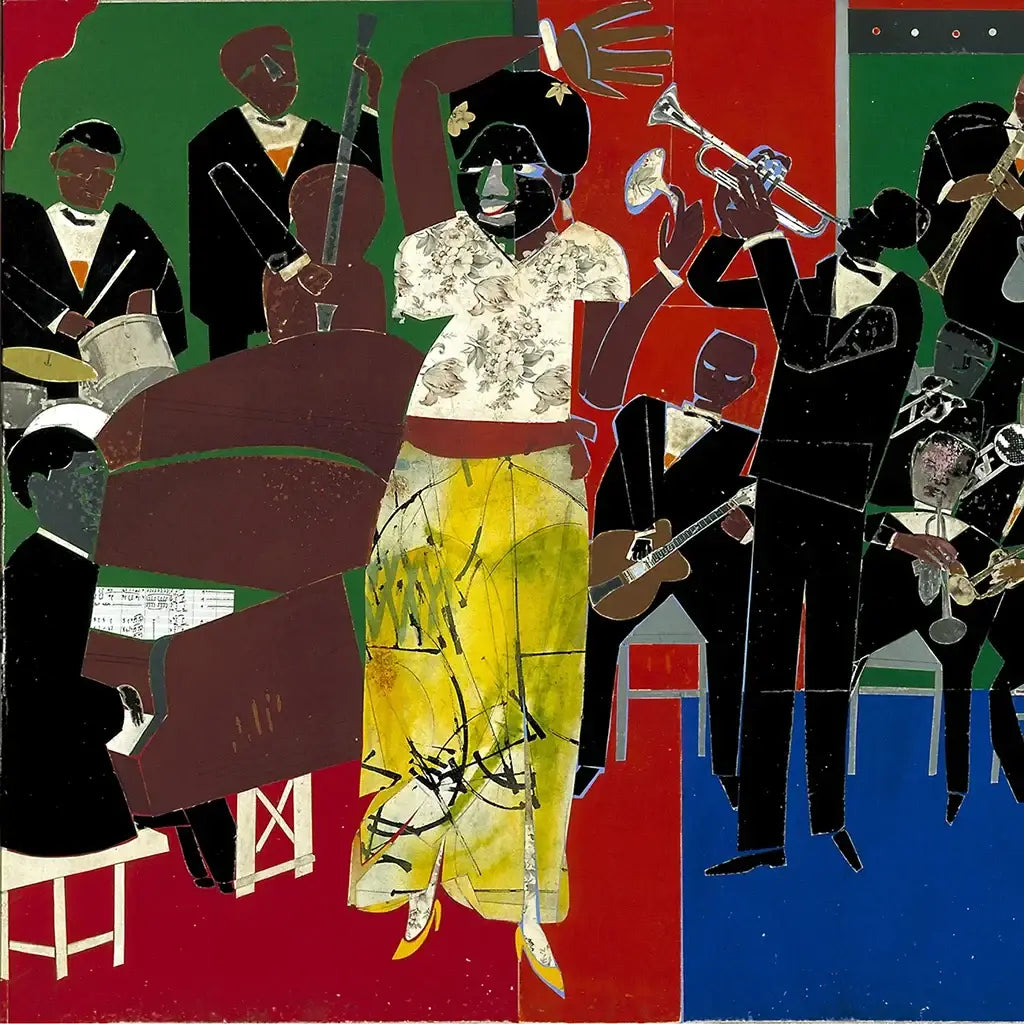
Romare Bearden, Empress of the Blues, 1974, acrylic and pencil on paper and printed paper on paperboard, 36 x 48 in. (91.4 x 121.9 cm.)
...
Romare Bearden (1911-1988) was an African American artist known for his powerful collage artworks that depicted the African American experience during his lifetime. Born in Charlotte, North Carolina, Bearden grew up in New York City and Pittsburgh, and studied at the Art Students League in New York City with George Grosz and at Columbia University. He worked with various media, including cartoons, oils, and collages.
Bearden's artwork consistently depicted African American culture and experience, covering rural themes based on his memories of the South, as well as urban life and jazz. His collage artwork often reflected elements of jazz, with interplay among characters and improvisation of materials. In the 1980s, he produced a large body of work featuring compelling images of women.
During the Harlem Renaissance, Romare Bearden's family home in New York City became a gathering place for prominent intellectuals and artists, such as W. E. B. Du Bois, Paul Robeson, and Countee Cullen. Growing up in this environment, Bearden was exposed to various art forms, including music, and met many well-known music legends of the time.
Despite being prolific, Bearden faced challenges in gaining recognition as a major American artist due to prejudices and segregation in the American art world. However, his exhibitions received enthusiastic responses, and in 1987, he was awarded the National Medal of Arts. Bearden also contributed as a songwriter, book illustrator, and set designer for the Alvin Ailey American Dance Company. In 1990, the Romare Bearden Foundation was established to support young or emerging artists and scholars.
In 1964, Bearden was appointed the first art director of the Harlem Cultural Council, a prominent African-American advocacy group. He was involved in founding several important art venues, such as The Studio Museum in Harlem and the Cinque Gallery. Bearden's contributions to the Harlem Renaissance extended beyond his artwork, as he actively supported young, emerging artists and advocated for African American culture and experiences.
Although Bearden is best known for his visual art, he was also a keen student of music, a lyricist, and a costume and set designer. His artwork often depicted African American culture and experiences, drawing inspiration from his life in Harlem and Pittsburgh.
3
John Heartfield
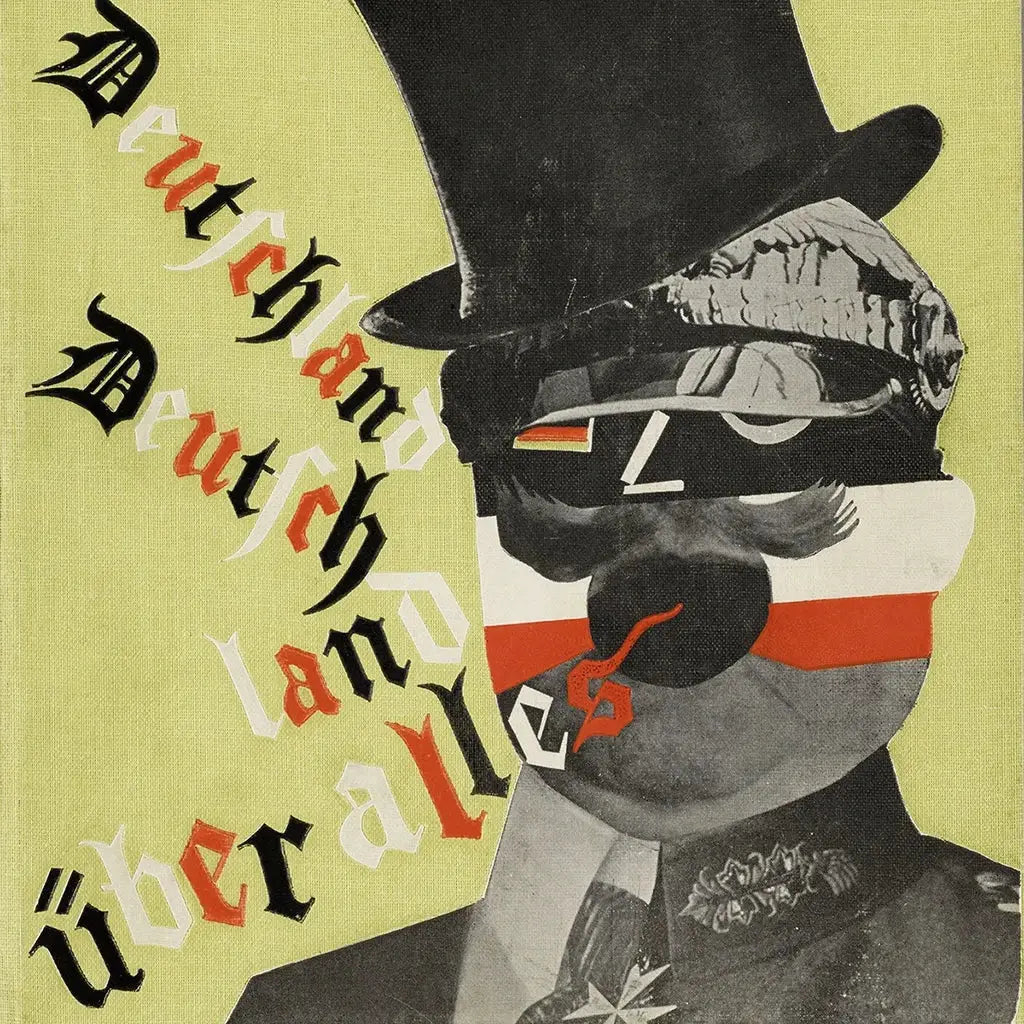
John Heartfield, Cover art for Kurt Tucholsky, Deutschland, Deutschland über alles, 1929 © The Heartfield Community of Heirs / VG Bild-Kunst, Bonn 2020 Akademie der Künste, Berlin.
...
John Heartfield (born Helmut Herzfeld; 1891-1968) was a German visual artist who pioneered the use of art as a political weapon, particularly through his anti-Nazi and anti-fascist photomontages. Heartfield's works often used satirical images and slogans to criticize the political climate of his time, especially against the rise of Adolf Hitler and the Third Reich.
Heartfield's photomontages are credited with creating some of the most iconic political posters of the 20th century due to their powerful visual impact and ability to convey strong political messages. From 1930 to 1938, he designed 240 pieces of anti-Nazi art, which were published in the AIZ magazine. These works were smuggled into Germany from Czechoslovakia, Austria, Switzerland, and Eastern France after the National Socialists took control.
Heartfield's artistic courage was equal to his physical courage, as he continued to create vehemently anti-fascist collages while living in Berlin until 1933. His photomontages foreshadowed the horrors of the Nazi regime and served as a powerful form of political protest, making him a significant figure in the history of political art.
John Heartfield's work has influenced numerous artists, graphic designers, typographers, advertisers, filmmakers, writers, and others who have found inspiration in his legacy. Artists from across the Eastern bloc, Soviet Russia, and the United States found inspiration in Heartfield's photomontages in the late 1960s and 1970s. For artists like Klaus Staeck, László Lakner, and Martha Rosler, among others, his work helped them confront worn-out leftist ideologies with a new visual language.
Heartfield's innovative use of transformed photomontage into a powerful form of mass communication. His unique method of appropriating and reusing photographs for political effect has inspired contemporary artists to use similar techniques to combat bigotry, ignorance, violence, and senseless war for profit. The John Heartfield Exhibition features work from collage artists such as Winston Smith, Thomas Young, and David King, who continue and expand on Heartfield's groundbreaking work.
4
Barbara Kruger
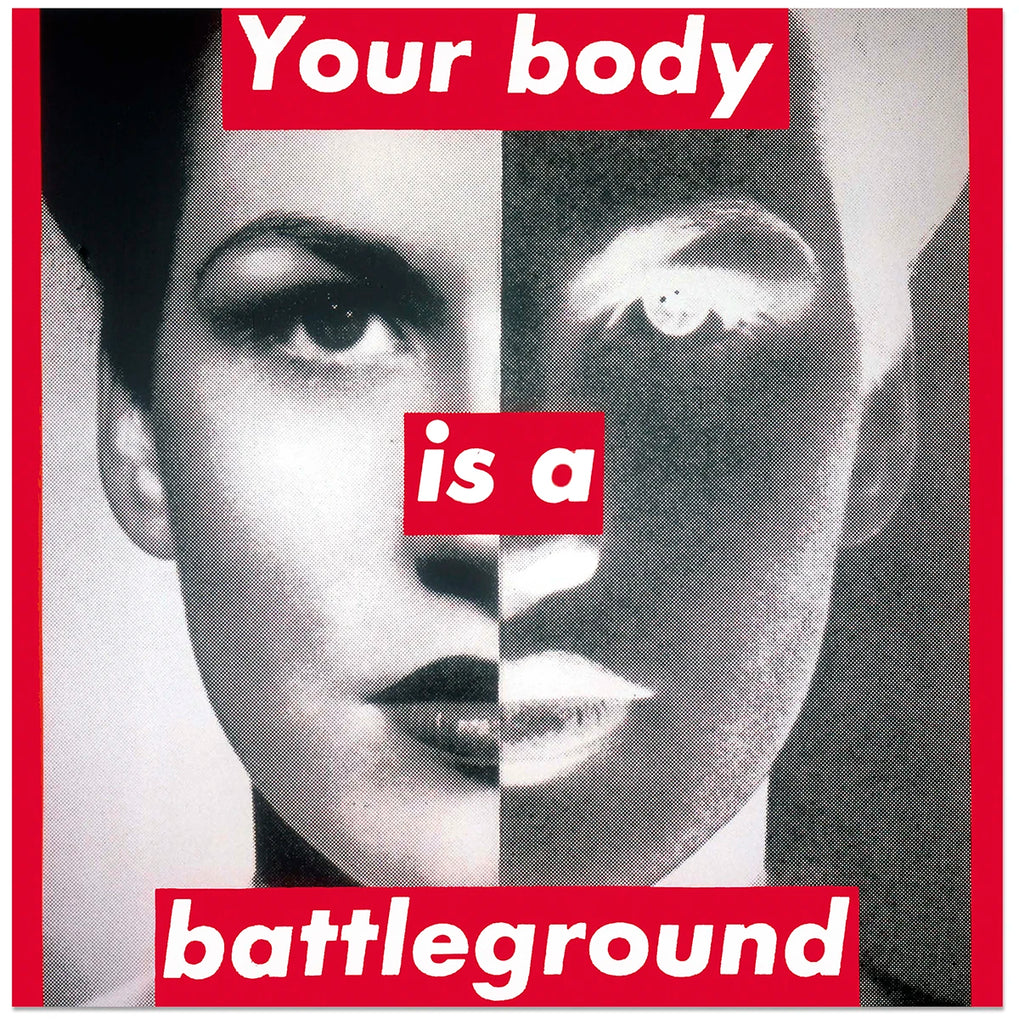
Barbara Kruger, Untitled (Your Body is a Battleground), 1989. Photographic silkscreen on vinyl. 112 x 112 in. (284.48 x 284.48 cm).
...
Barbara Kruger (born January 26, 1945) is an American conceptual artist and collagist associated with the Pictures Generation. She is known for her bold and provocative collage artworks that question the role of women in society, using black-and-white photographs overlaid with declarative captions in white-on-red Futura Bold Oblique or Helvetica Ultra Condensed text. Kruger's work often includes large-scale text overlaid on images to challenge cultural assumptions and prompt viewers to question mainstream media messages and their impact on identity and society.
Kruger's signature style was influenced by her classical training in design and her experience in the fashion industry, particularly as chief designer at Mademoiselle magazine. Her work was shaped by feminist film criticism and structuralist literary theory, which she encountered through her participation in the Artists Meeting for Social Change group.
Kruger's art addresses issues such as consumerism, sexuality, politics, and the relationship between power and society, blurring the boundaries between art and commerciality. She is considered one of the most important feminist artists of the 20th century due to her ability to challenge and question notions of identity and power structures through her thought-provoking and visually striking works.
Hear Kruger talk about her art in her own words.
Some of Kruger's most important works include:
"Untitled (Your Body Is a Battleground)" (1989): This work features a black-and-white photograph of a woman's face, split in half, with the text "Your body is a battleground" overlaid. It was created in response to the political debate surrounding women's reproductive rights and serves as a powerful commentary on the struggle for control over women's bodies.
"Untitled (I Shop Therefore I Am)" (1987): This piece features the phrase "I shop therefore I am" superimposed on a hand holding a credit card. It critiques consumerism and the way it shapes our identities and values.
5
Robert Rauschenberg
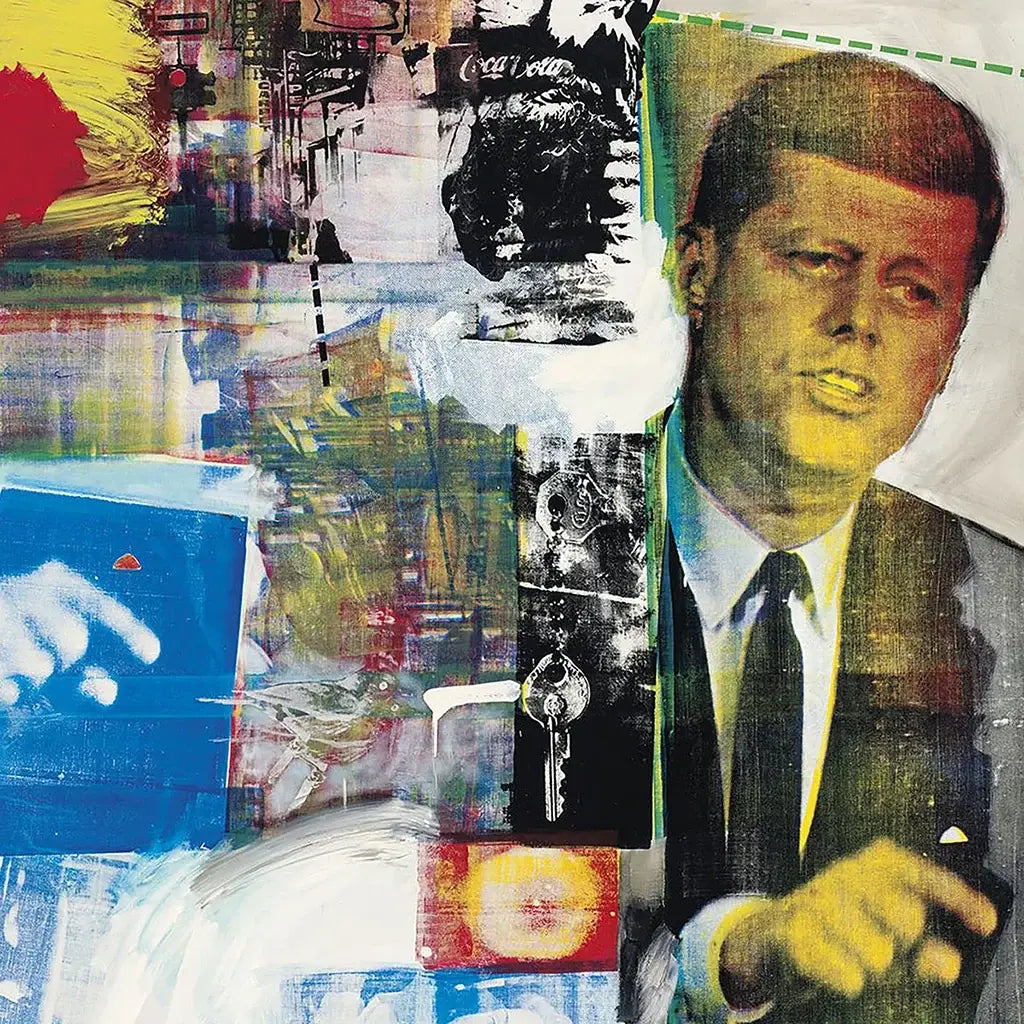
Robert Rauschenberg, Buffalo II, 1964. Oil and silkscreen ink on canvas
96 x 72 in. (243.8 x 183.8 cm.).
...
Robert Rauschenberg (1925-2008) was an American painter and graphic artist known for his "combine" works, which blurred the distinctions between painting and sculpture by incorporating everyday objects as art materials. He studied art at the Kansas City Art Institute, Academie Julian in Paris, and Black Mountain College in North Carolina before moving to New York City in 1949.
Rauschenberg's combines integrated discarded objects he collected from the streets of New York City, such as newspaper clippings, photographs, and found objects. He believed that using real-world materials made his art more relatable and reflective of reality. Some of his early works anticipated the Pop art movement, and he is celebrated as a forerunner for nearly every art movement since Abstract Expressionism.
Robert Rauschenberg's contributions to the art world were significant and transformative. He was a primary figure during the 1950s and 1960s and became recognized as a major forerunner of American Pop art, alongside contemporaries like Andy Warhol and Jasper Johns. Rauschenberg's innovative approaches, seen in works like Monogram, expanded the traditional boundaries of art. Opening up new avenues of exploration for future artists.
His "combine" works blurred the distinctions between painting and sculpture, incorporating everyday objects as art materials and challenging the status quo. Rauschenberg's art practice and creative energy was never going to fit into preconceived boxes. Art historian Branden W. Joseph noted that Rauschenberg's work served as a stimulus, an impetus, and a challenge for artists across the board.
Throughout his career, Rauschenberg worked in various mediums, including painting, sculpture, prints, photography, and performance. He collaborated with choreographers like Merce Cunningham, Paul Taylor, and Trisha Brown, and was a founding member of the innovative group Experiments in Art and Technology (E.A.T.) in 1966.
Rauschenberg's groundbreaking approach and creative energy had a lasting influence on generations of artists. Hear how Rauschenberg "rewrote the rules of the game" from his son, photographer Chris Rauschenberg.
6
Kurt Schwitters
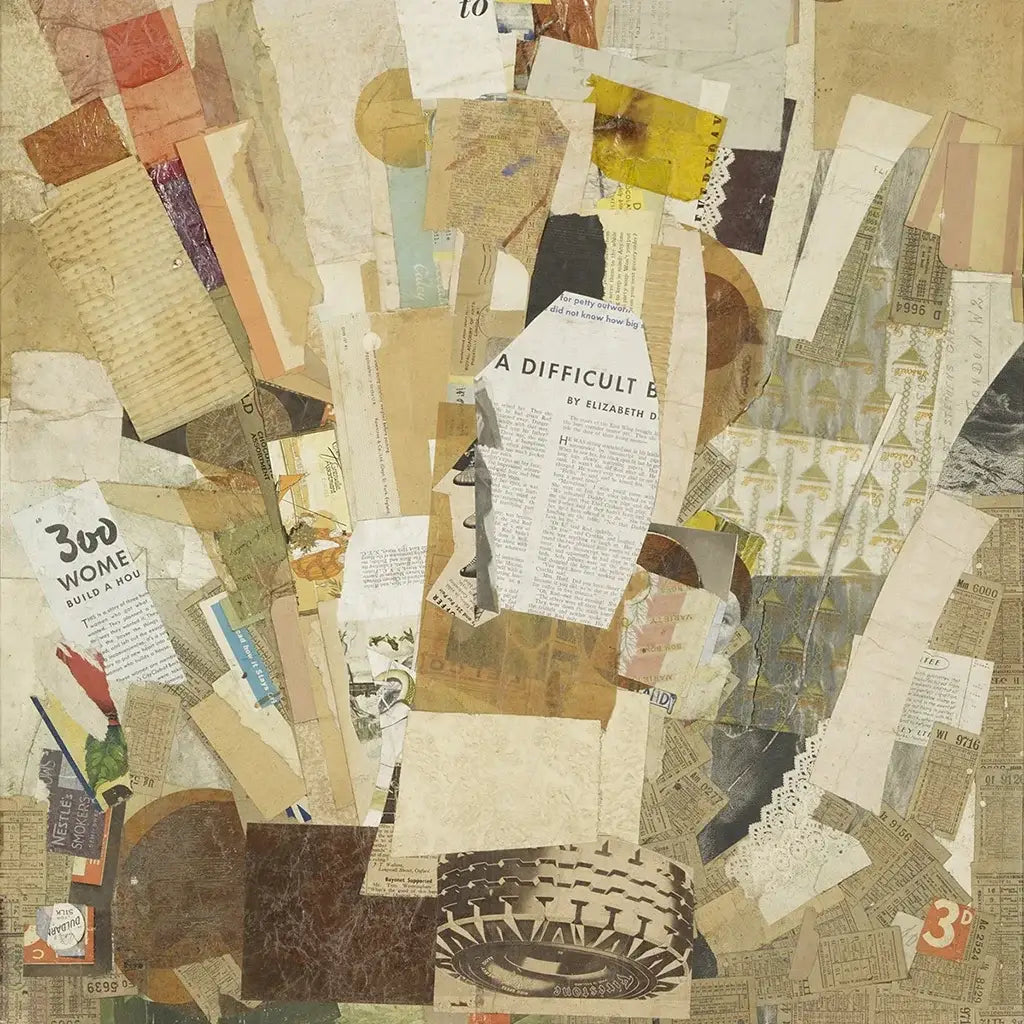
Kurt Schwitters, Difficult, 1942-43. Collage. 31.25 x 24 inches (79.37 x 60.96 cm).
...
Kurt Schwitters (1887-1948) was a German artist involved in both Dadaism and Constructivism, best known for his Merz and Merzbau works. He coined the term "Merz" to describe his unique style of art that involved using everyday objects to create his works. Schwitters created Merzbild (Merz-paintings), which were collages and assemblages made from various waste materials, such as prints, labels, wallpapers, and pieces of wood. And he never shied away from pointed, searing subject matter, including his time in Hutchinson internment camp.
Schwitters' Merz concept was a subsect of the Dada movement, tailored to his own artistic philosophies and visions. The name Merz was generated by chance through a collage that incorporated the German word "Kommerz" (commerce). This nonsensical and spontaneously generated word was similar in origin and philosophy to the title of Dada.
While Merz and Dada art are closely related, there are some differences between the two. Merz is a subsect of the Dada movement that was tailored to Schwitters' own artistic philosophies and visions. On the other hand, Dada was a broader art movement that encompassed various forms of art, including performance art, poetry, photography, sculpture, painting, and collage. Dada's aesthetic was marked by its mockery of materialistic and nationalistic attitudes.
Throughout his life, Schwitters created over 8,000 works, with around 2,500 remaining today. His innovative approach to art, fusing collage and abstraction, influenced artists such as Robert Rauschenberg. Schwitters was an outsider and individualist, choosing not to move to major artistic centers like Berlin or Paris after completing his studies at the Dresden Academy.
7
Eduardo Paolozzi
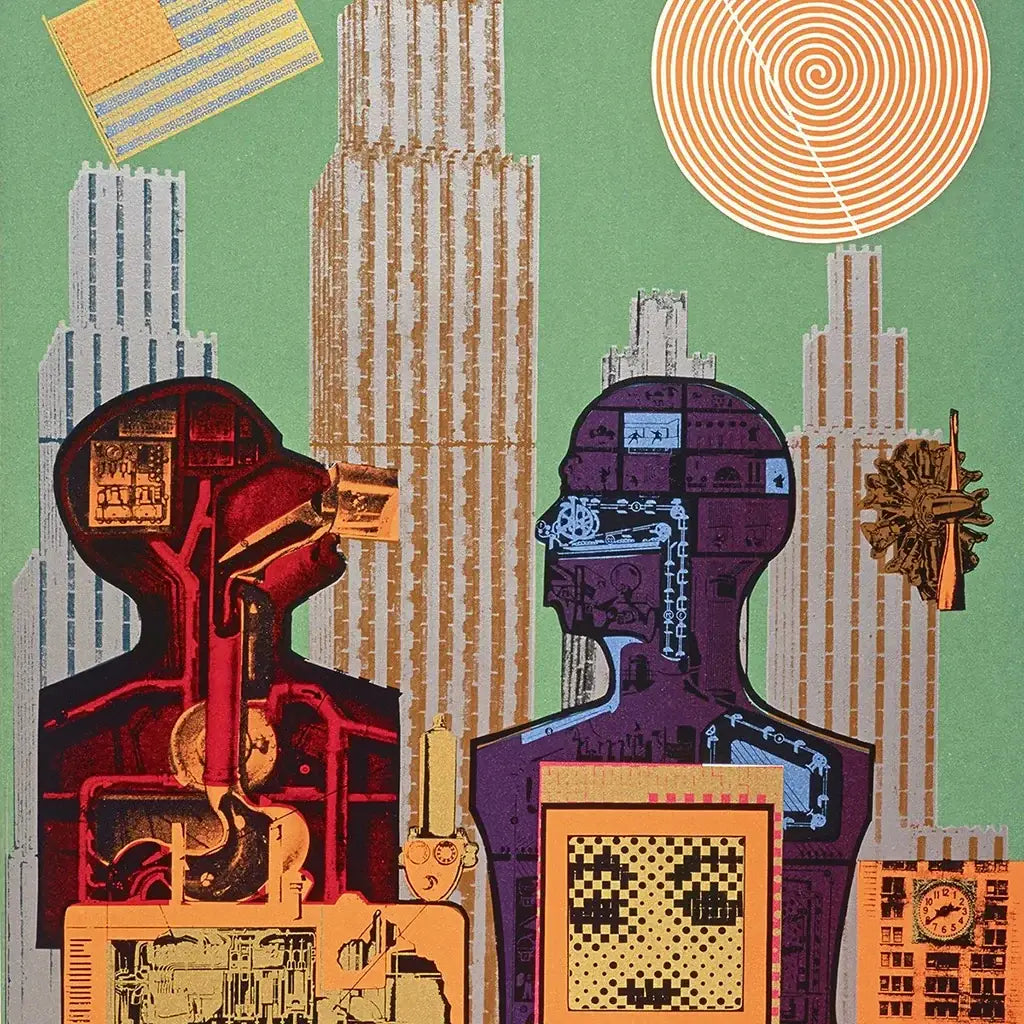
...
Eduardo Paolozzi (1924-2005) was a Scottish artist known for his innovative collage works that incorporated a mix of images from popular culture and technology. Born in Leith near Edinburgh to Italian parents, Paolozzi studied in Edinburgh and London before spending two years in Paris. He is widely considered to be one of the pioneers of Pop Art.
Paolozzi's works often challenged traditional notions of art and beauty by combining elements of Surrealism with popular culture, modern machinery, and technology. His early love for American culture led him to create collages using images from advertisements, representing the shinier, happier lifestyles that were emerging in post-war America. But he also played with that form and style — transmuting its over the top sensibilities into his mosaics and sculptures, most notably at Tottenham Court Road tube station.
His works were surreal in nature, as he combined magazine advertisements, cartoons, and machine parts into his art, anticipating the concerns of Pop Art. Paolozzi was particularly interested in the mass media and in science and technology, which influenced his art throughout his career. In addition to his collage works, Paolozzi also produced large-scale figurative sculptures, prints, and mosaic murals — their vibrant appeal lending "a kind of focus to the chaos".
8
Martha Rosler
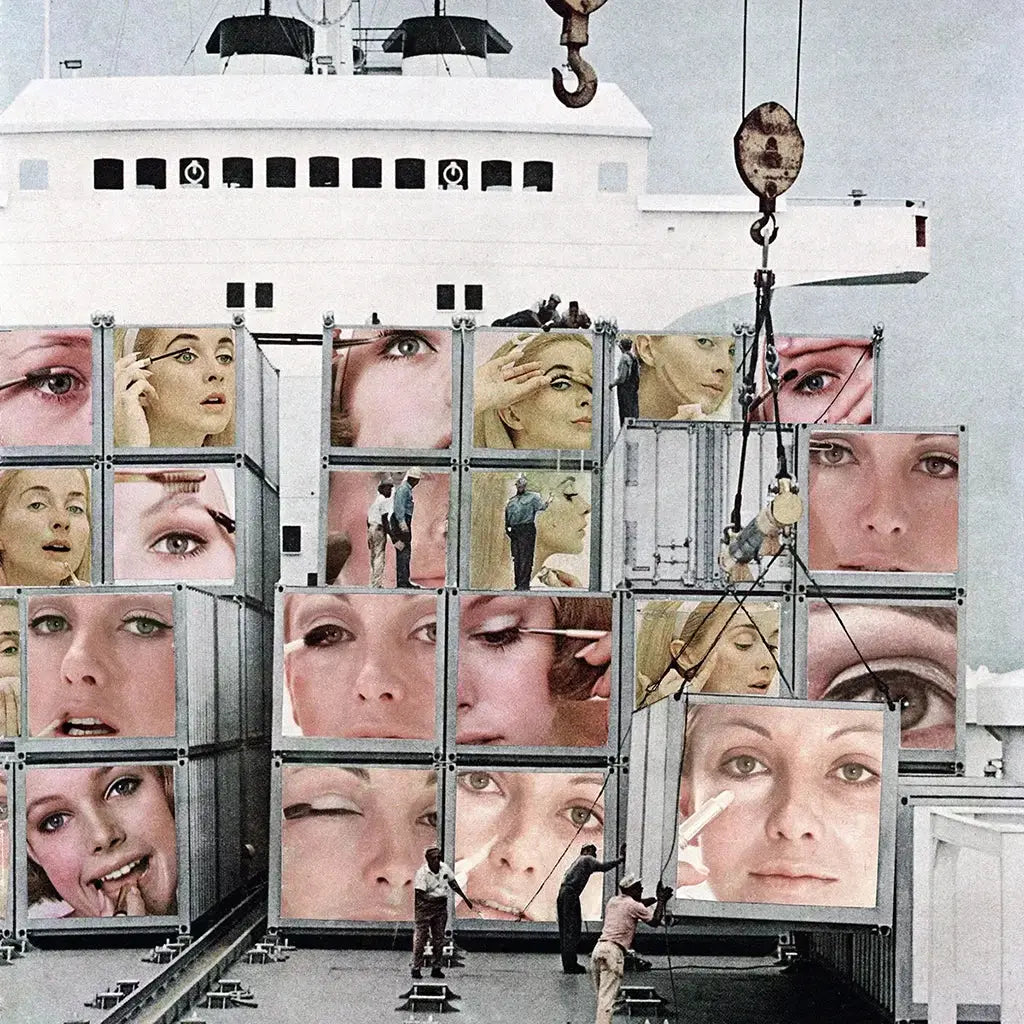
Martha Rosler, Cargo Cult, from the series Body Beautiful, or Beauty Knows No Pain, 1966–72. Photomontage printed as photograph. 39 1/2 x 30 1/4 in.
...
Martha Rosler, born in 1943 in Brooklyn, New York, is an American conceptual artist known for her feminist collages and photomontages. She works in various mediums, including photography, photo text, video, installation, sculpture, and performance, as well as writing about art and culture. Rosler's work often incorporates images from popular culture and advertising to question the role of women in society and challenge traditional gender roles.
Martha Rosler's work significantly influenced the feminist art movement by questioning the portrayal of women in society. She also used new technologies, such as video, to differentiate herself from male artists and the more traditional mediums of the art world. In the mid-1960s, she began creating photomontages exploring women's material and psychic subjugation, manipulating popular advertisements to expose their underlying ideologies. Her work, such as the "Body Beautiful, or Beauty Knows No Pain" series (1966–72), combined various conceptual art practices attuned to feminist politics.
One of her widely known works, "Semiotics of the Kitchen" (1975), is a video parody of cooking shows that humorously addresses the implications of traditional female roles. By appropriating elements of pop culture, such as television and magazine advertising, Rosler's work critiques societal norms and expectations surrounding women.
Rosler's art practice extended beyond subject matter, as she believed that art could genuinely occupy a social role and provoke empathy and disidentification in the viewer. Her video works from the 1970s and 1980s scrutinized mass media's operations to reveal how they cultivated a complacent public. Influenced by the wave of feminist performance emerging from alternative art spaces in California, Rosler's work contributed to the development of feminist conceptual art and left an indelible mark on the contemporary arts scene.
9
Georges Braque
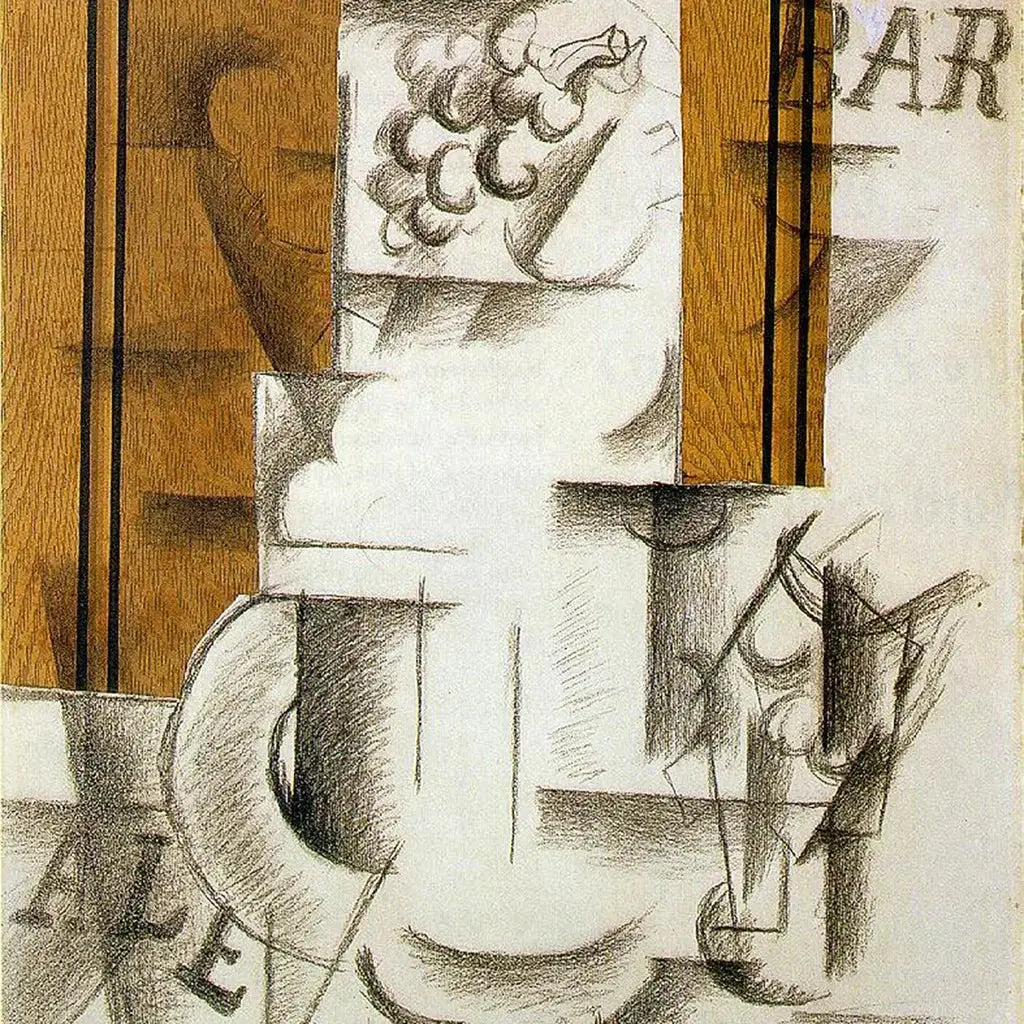
...
Georges Braque, along with Pablo Picasso, played a significant role in the evolution of collage art. They invented the technique of papier collé (pasted paper) in 1912, which marked a revolutionary shift in the art world. Braque took collage one step further by gluing cut-up advertisements into his canvases. He also stenciled letters onto paintings, blended pigments with sand, and copied wood grain and marble to achieve great levels of dimension in his paintings. Of course, collage existed well before then in other forms...
Braque's collage artwork, such as his 1912 artwork "Fruit Dish and Glass", combined pieces of faux-wood wallpaper with his Cubist depictions of objects. This technique called into question the formal ideas of perspective and space within art, as it created intersecting areas of collage elements and drawing within his work. His innovative approach to collage art influenced many contemporary artists and contributed to the growth and expansion of the collage art form.
During the collage phase of Cubism from 1912–14, inanimate objects dominated the imagery of Picasso, Braque, and Juan Gris. Braque's still lifes possessed an undercurrent of human drama, thanks to the ingenious combination of things and text. The use of real materials and textures in their collage compositions introduced a new dimension to Western painting, whose repercussions are still felt today.
Braque's work with collage had a lasting impact on the art world, inspiring artists across various movements, mediums, and styles to explore the practice of collage art. The inventive and innovative approach to art attracted artists due to its one-of-a-kind aesthetic and unique, pieced-together process. As a result, Braque's influence on the evolution of collage art is evident in the works of many artists who followed, such as Jessica Stockholder, Mark Bradford, Hannah Hoch, Kurt Schwitters, and John Stezaker.
10
Pablo Picasso
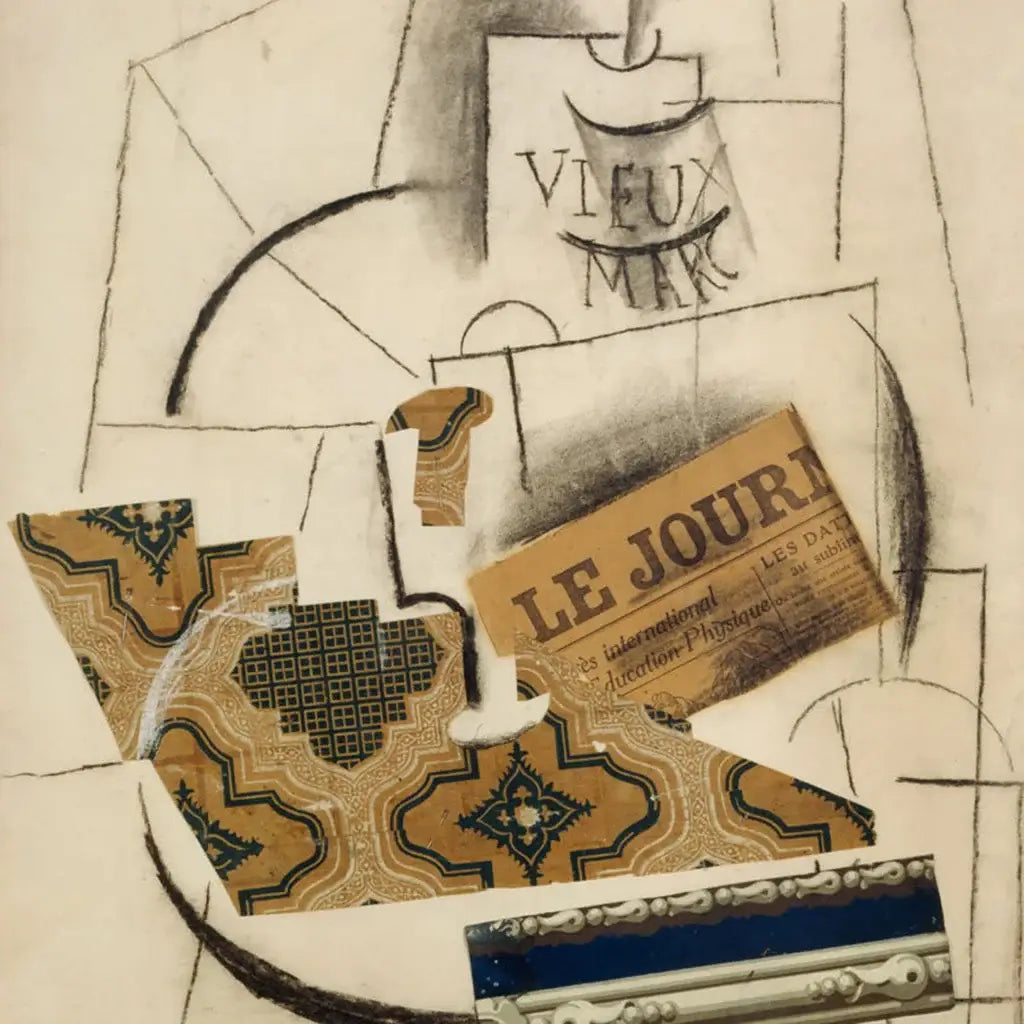
Pablo Picasso, The Bottle of Vieux Marc, 1913. Cut-and-pasted printed wallpapers, newspaper, charcoal, gouache, and pins on laid paper, 24 13/16 × 19 5/16 in. (63 × 49 cm).
...
Pablo Picasso, along with Georges Braque, played a crucial role in the evolution of collage art. They developed the technique of papier collé (pasted paper) in 1912, which marked a groundbreaking shift in the art world. Picasso's innovative approach to collage art inspired other artists and became a catalyst for artistic movements such as Cubism, Dada, and Surrealism.
One of Picasso's early collage work, "Guitar and Wine Glass," demonstrates his ability to create shading and structure by pasting and layering paper. His 1912 artwork "Still Life with Chair Caning" is another significant example of his collage work. In this piece, Picasso incorporated a piece of oilcloth with a chair caning pattern and a rope to frame the composition. This artwork challenged traditional ideas of art by combining everyday materials with painted elements, blurring the boundaries between high and low culture.
Picasso's collage works had a profound impact on the art world, inspiring artists across various movements, mediums, and styles to explore the practice of collage art. His inventive and innovative approach to art attracted artists due to its unique aesthetic and pieced-together process. As a result, Picasso's influence on the evolution of collage art is evident in the works of many artists who followed, such as David Hockney, Jasper Johns, and Martin Kippenberger.
11
Henri Matisse
Henri Matisse, Zulma, 1950. Gouache on paper. 108 x 60 inches.
...
Henri Matisse's cut-outs, created during the last decade of his life, had a significant impact on our contemporary understanding of collage art. In the late 1940s, Matisse shifted his artistic methodology and turned to cut paper as his primary medium, using scissors as his tool. His cut-outs, often inspired by the natural world or abstract forms, were arranged into lively compositions that transcended the confines of easel painting and allowed him to work with a new type of free reign. Many consider this period to be "a second life" for the artist. Can't you just see the look of contentment on his face in this rare footage making a paper cut-out?
Matisse's cut-outs showcased his incredible creativity and vitality, even in challenging circumstances. They represented the pinnacle of his career, marking the ultimate transition to an entirely abstract vocabulary. His mastery of the cut-out style had a profound impact on his artistic journey. The cut-outs also introduced a new operation in art, which came to be known as "drawing with scissors". Which present their own preservation challenges, as you can see in this painstaking restoration process.
Matisse's cut-outs influenced many modern abstract artists and continue to inspire artists and curators. The simplicity of his cut-outs was unexpected in the art world, and they were considered wholly unique and radical at the time they were being made. His cut-outs stripped down to basic color and shape, taking on an almost graphical nature, which might explain the resurgence of the aesthetic in illustration and graphic design.
...
Collage art is a unique and versatile medium that allows for endless creative possibilities. The famous collage artworks mentioned in this article have all made significant contributions to the art world through their innovative styles and techniques. Each artist has their own unique perspective, and their impact on the art world has resonated with other artists and influenced their work.
Whether it's using everyday objects, political satire, or questioning traditional gender roles, collage art has the ability to communicate complex messages in a visually stunning way. These artists have shown that collage art is more than just cutting and pasting, it's a powerful medium for self-expression and social commentary.
—
For Lazy Nerds & Visual Learners
Famous Collage Artists on YouTube
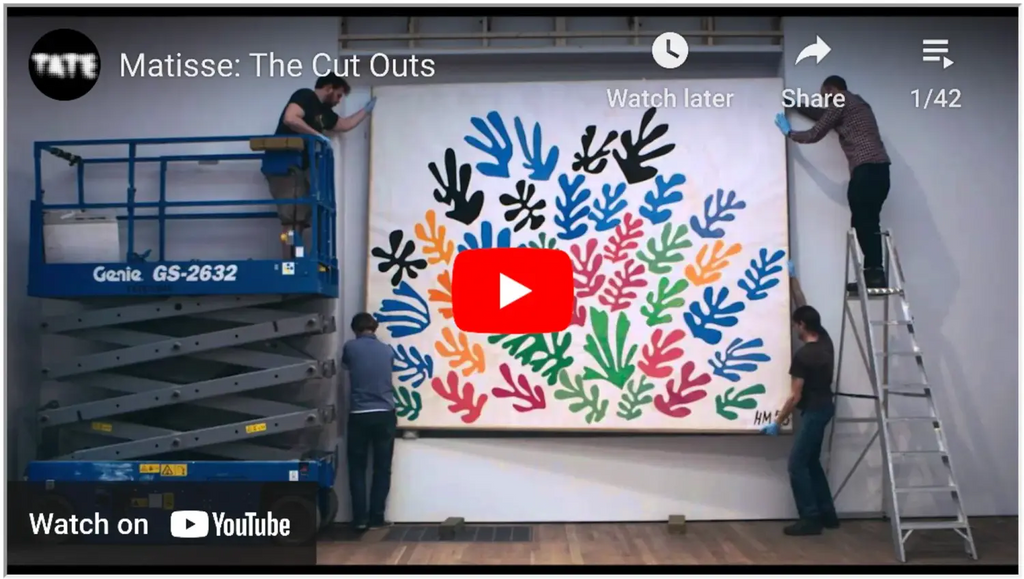
ICYMI
Which artist made the concept of collage into a form of art in 1912?
In 1912, the pioneering artist who transformed the concept of collage into a distinct form of art was none other than Pablo Picasso. During this year, Picasso unveiled "Still Life with Chair Caning," a remarkable work that marked the advent of collage as a significant artistic expression and marked the initiation of a new phase in the Cubist movement.
"Still Life with Chair Caning" featured an unconventional combination of materials and techniques. Picasso incorporated a strip of oilcloth printed with a chair caning pattern onto an oval-shaped canvas. The painting was further framed with a rope. This innovative fusion of various elements, along with the incorporation of non-traditional materials, like the oilcloth, challenged conventional artistic norms and introduced an avant-garde approach to art-making. This groundbreaking artwork paved the way for the exploration of new possibilities in visual representation and significantly expanded the boundaries of artistic expression.
In addition to its impact on visual arts, Picasso's innovative use of collage had broader implications for artistic philosophy and creative thought. The introduction of collage as a viable artform challenged established ideas about the nature of art materials, composition, and representation. This approach encouraged artists to explore unconventional materials, textures, and forms, fostering a spirit of experimentation and redefinition within the artistic community.
The work of Hannah Höch is considered to be a part of what artistic style?
Hannah Höch's artistic style is firmly associated with Dadaism, an avant-garde movement that aimed to challenge traditional notions of art and society through its embrace of absurdity, anti-conformity, and experimentation.
Höch is best known for her photomontage works, a technique where she skillfully combined and juxtaposed cut-out images from magazines and newspapers to create intricate and thought-provoking collages. Her photomontages often featured a satirical and critical commentary on social and political issues, reflecting the Dadaist rejection of established norms and values.
Höch's participation in Dadaism and her mastery of photomontage techniques played a significant role in expanding the artistic possibilities of the movement. Her work challenged the prevailing notions of authorship and originality by appropriating and recontextualizing existing imagery, which resonated with Dada's ethos of subversion and iconoclasm.
Future Forecast
Why was the dada artistic movement important to future artists?
The Dada artistic movement holds profound significance for future artists due to its radical departure from conventional artistic norms, its subversion of established institutions, and its role in paving the way for subsequent avant-garde and experimental art forms. Emerging during World War I as a reaction against the horrors of war and the societal norms that seemed to have led to it, Dadaism was a force that shattered traditional artistic boundaries. Countless artists were inspired by the wild antics and bold anti-authoritarian nature of Dada, motivating them to expand the horizons of the art world.
One of the most iconic figures of Dadaism was Marcel Duchamp, known for his groundbreaking work "Fountain," a porcelain urinal signed with the pseudonym "R. Mutt." Duchamp's creation epitomized Dada's anti-art ethos, challenging traditional notions of aesthetics and forcing viewers to question the very essence of art. This audacious act had a profound impact on future artists by pushing them to rethink the very definition and boundaries of artistic expression.
The Dada movement played a pivotal role in changing the perception of art and breaking established rules. It disrupted traditional artistic mediums by incorporating found objects, collage techniques, and performance art, setting a precedent for artists to experiment with unconventional materials and methods. Dadaism's rejection of logic and its embrace of absurdity and irrationality influenced later movements such as Surrealism, which also aimed to tap into the unconscious mind and challenge rationality in art.
The movement's influence extended beyond artistic practices to challenge societal norms and authority. By ridiculing and rejecting conventions, Dadaists confronted the status quo, inspiring future generations of artists to use their creative expressions as a means of social critique and change. Dada's anti-establishment stance and its exploration of randomness, chance, and spontaneity also contributed to the development of conceptual art and performance art, both of which prioritize ideas and process over traditional aesthetic outcomes.
...
Main image: Eduardo Paolozzi, Turing 6, 2001. Colour photo-screenprint. 64 × 53 cm.

